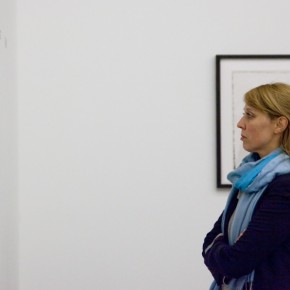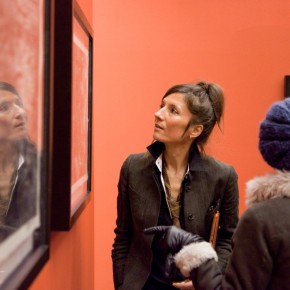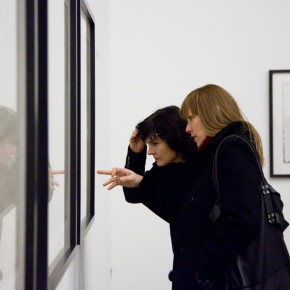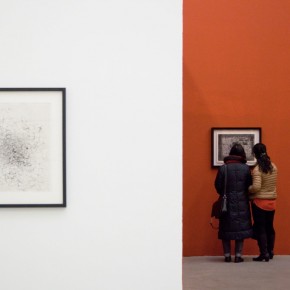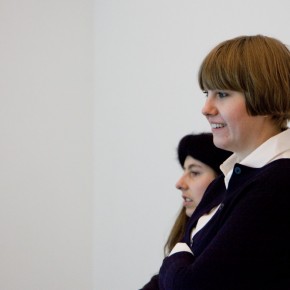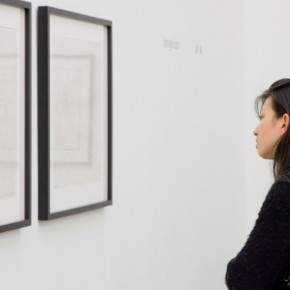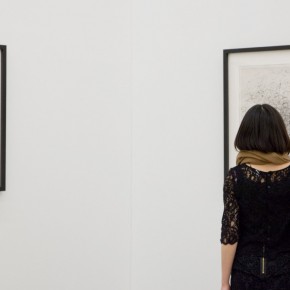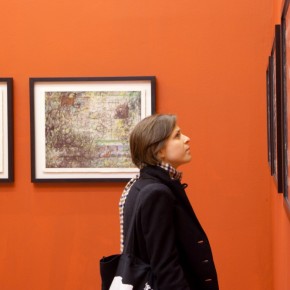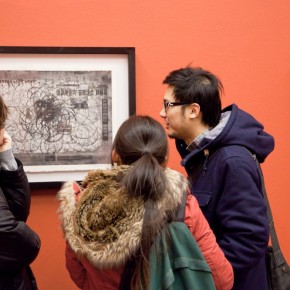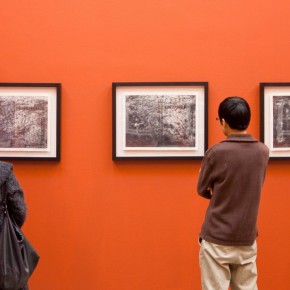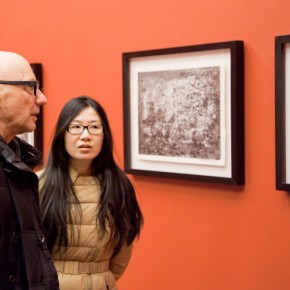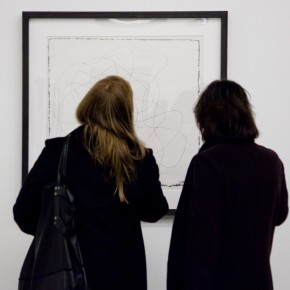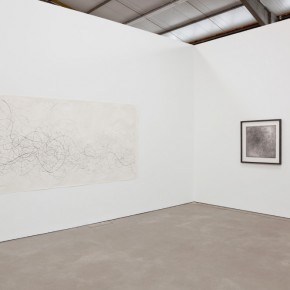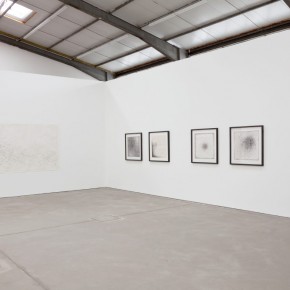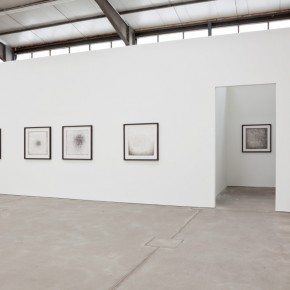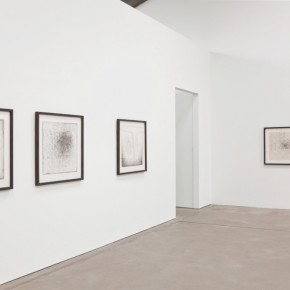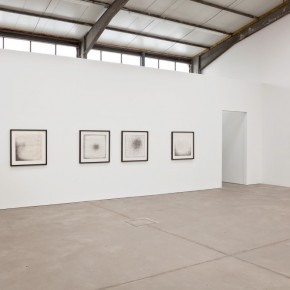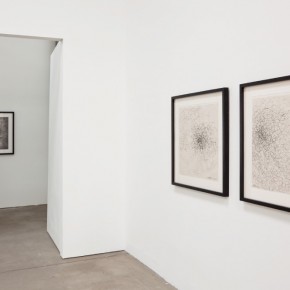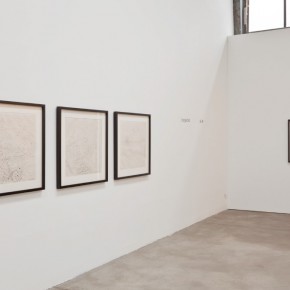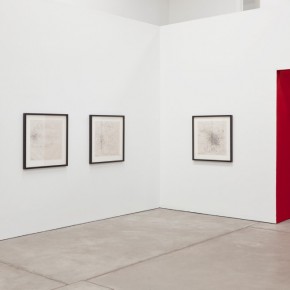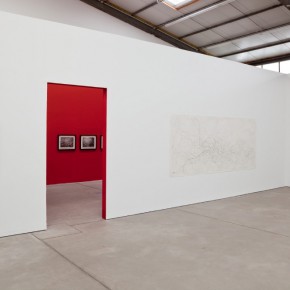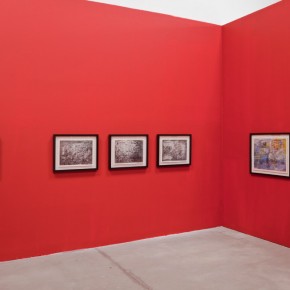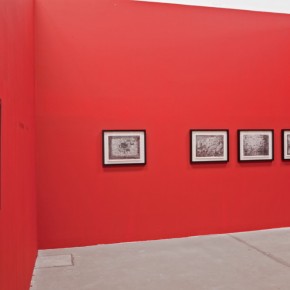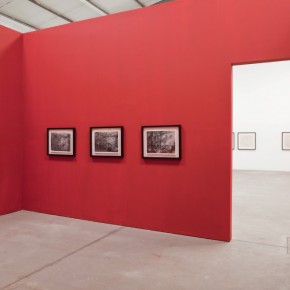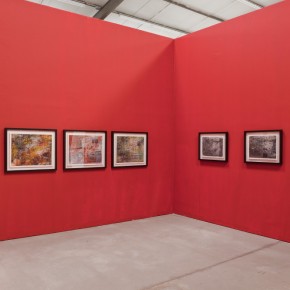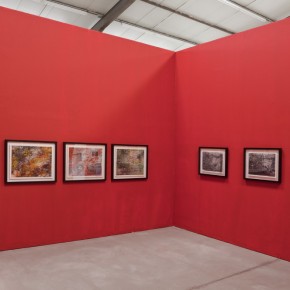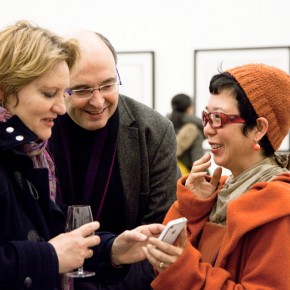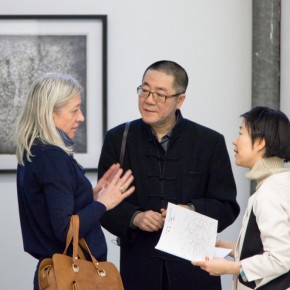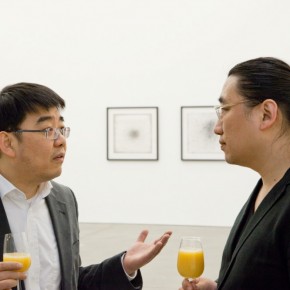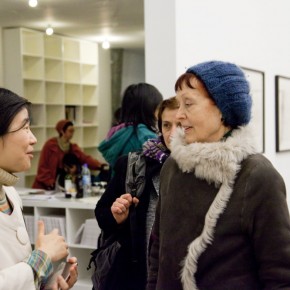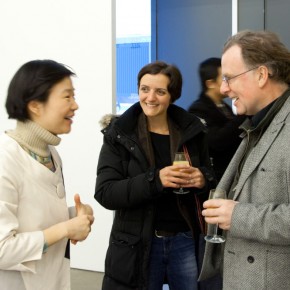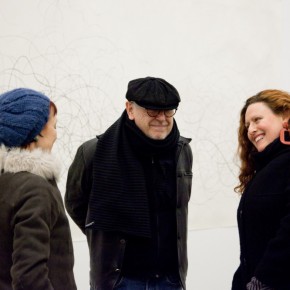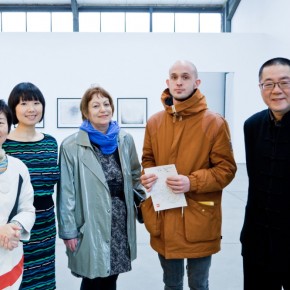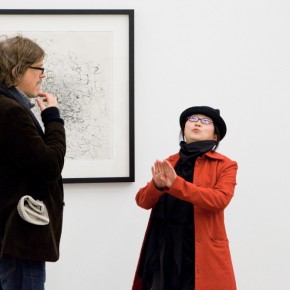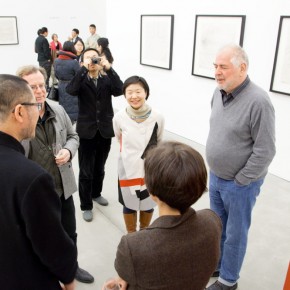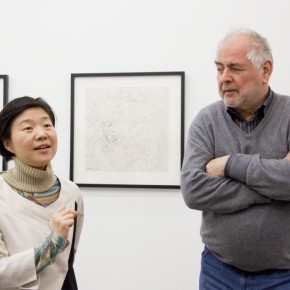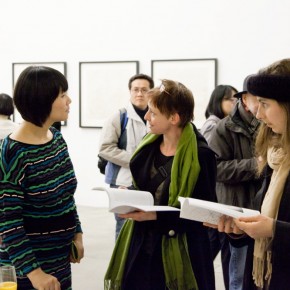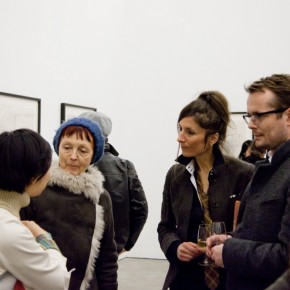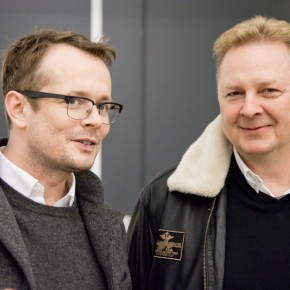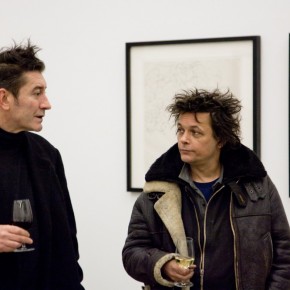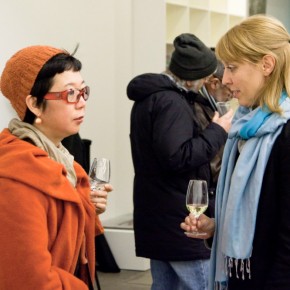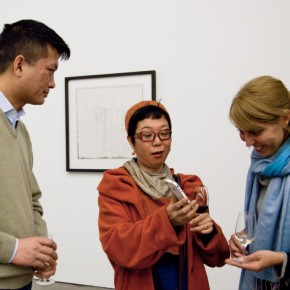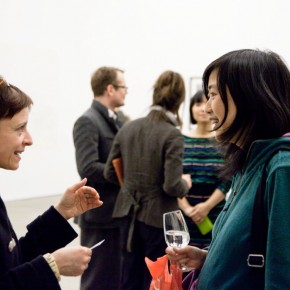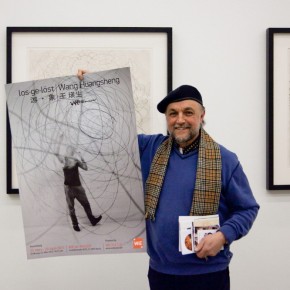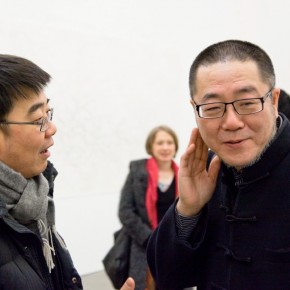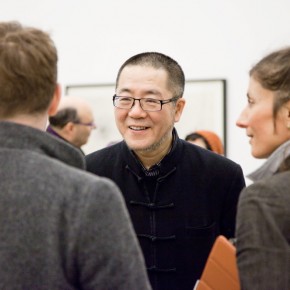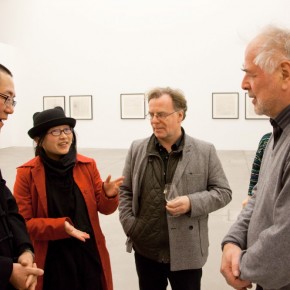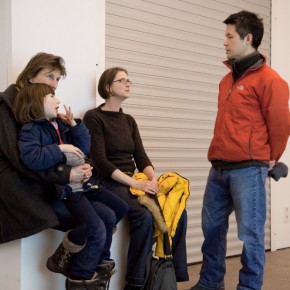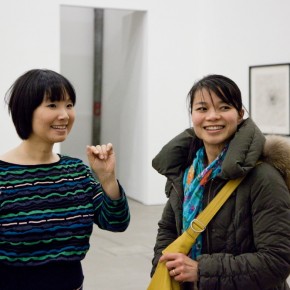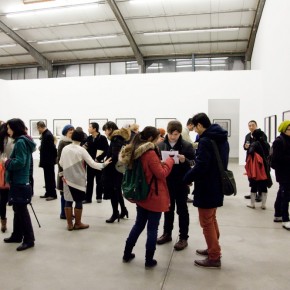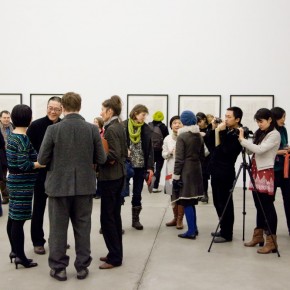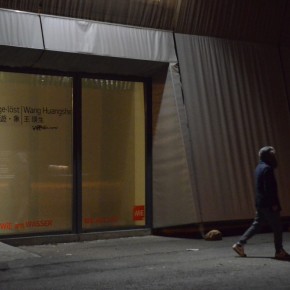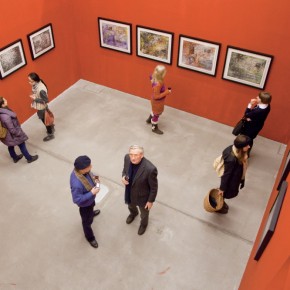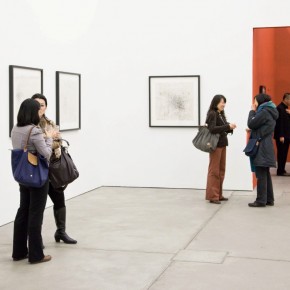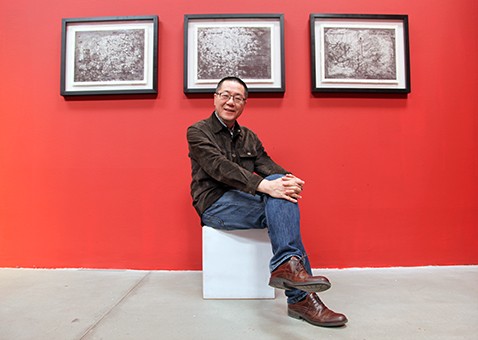
Artist Wang Huangsheng sitting in the hot seat with Berlin Art Parasites.
Photo by C. Phillips
Wie am Wasser might appear to be a grey, castaway building stranded in the overlooked parking area behind Hamburger Bahnhof. Yet if this building were an island, it would definitely be a treasure one. Today its doors happen to unlock an airy project space welcoming wanderers into what I like to call “a meditative nowhere,” a place where the here and now condense into unexpected reverie. This state is the result of the work presently on display by Chinese artist, art historian and critic Wang Huangsheng, who is currently having his first solo exhibition in Europe, “los•ge•löst,” organized by Wie Kultur. Widely regarded as the preeminent museum director in China for his role with the Art Museum of the Central Academy of Fine Arts in Beijing (CAFA), this multifaceted and hyper-productive artist has been heavily honored with international accolades for his contribution to culture and the development of art in China.
Searching For Wang Huangsheng
At the opening of “los•ge•löst” I was more lost than anything else by the behavior of the artist: instead of commanding his role as the center of attention, he kept wandering around the exhibition space sparking conversation and making connections here and there with the visitors, some known to him and others complete strangers, like me. This behavior appeared to echo in his drawings and paintings on the walls: a lone line of a brushstroke flowing and wandering around the paper, making unlikely liaisons and unpredictable shapes until it ran out of ink. Sounds simple, but trust me, it is that type of profound simplicity that’s so difficult to find nowadays in our complex information age where a lot of our roaming and connections happen online. On the lines of this artist's paper I instead found something else: the “you had to be there” characteristic of the meditative nowhere.
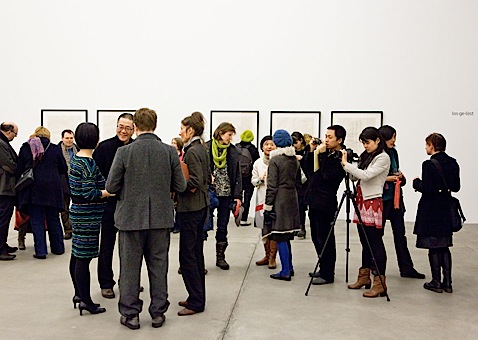
Wang Huangsheng (center left) roaming and connecting.
Photo by Daisy Loewl, courtesy of gallery
Shortly after we made some small talk, I sensed there was an immense river of poetry flowing in the character of Wang Huangsheng––a hint that was also apparent in the profound simplicity of his body of work. I felt I needed to know more about both his art and heart, but with the crowd, the cameras and the attention, the waters that night at Wie am Wasser were too busy for any tranquil conversation. Fortunately, he was kind enough to give BAPs an exclusive interview at a later date. The search for Wang Huangsheng was about to reach its end. Or so I thought.
Finding Wang Huangsheng
The morning of the interview, both the artist and Chen Yang, the founder & director of Wie Kultur who would assist in translating our exchange, were already expecting us with tea, coffee, and––at my later request––wine (hey, I had a rough morning and wanted to loosen up, okay?). I had expected to ask him the routine questions: about the show's title, for example, which means both "roaming" and "apparition," perhaps an implication of the way he roams the paper until the ink runs out and he's left with the final image. But once there, sitting in the strange comfort of his presence, I became very much at ease (it wasn't the wine, I'm sure) and a more sincere conversation began to take hold between us.
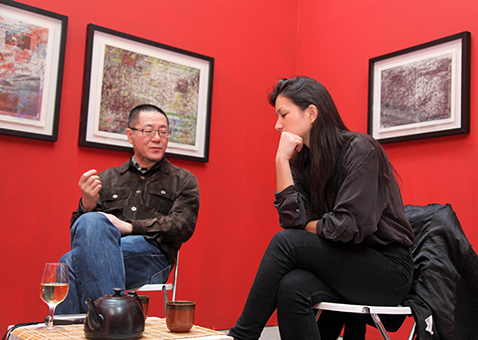
Wang Huangsheng (L) talking art, heart, smoke and meditation with Carmen Herold. Photo by C. Phillips
BAPs: I enter your work through a sort of meditative empathy. I follow the ink thread you leave behind on the paper and, although I cannot possibly know your thoughts as you made it, I encounter myself with my own thoughts through your lines. What role does meditation have in your work?
WH: This is a very interesting angle. While not having the type of “spirituality” you may be able to identify with, Chinese people do have their own beliefs, a sort of "original sense."Everyday a new high level of awareness is reached. So yes, my art is quite meditative.
BAPs: But is this meditation a type of detachment from the world?
WH: You might see that when you focus on the surface of the paper, you are temporarily detached from the world. Other friends and colleagues have also pointed out that the intertwined complexity of the lines reflects the very complexity of the world. You know, the rhythm that this complexity indicates. So, in this sense, it is not entirely detached. It is part of it, directed to reflect on it. In the work there is no absence from the world; the world is always present.

Wang Huansheng expanding on the connections found in detachment;
Photo by Chris Phillips
BAPs: During the act of creation, what does the space around you look like? Are you alone or does it take place in public?
WH: The work requires, quite exclusively, a certain amount of time around the day to be by myself. This isolation is very important to me. Particularly, I like to use an incense fragrance––Sandalwood––in my studio as I work. The burning incense also creates smoke flowing in the air. This is an inspiring resource for me (that I integrate in my movement).
BAPs: What do you mean? Do you imitate the smoke in your lines?
WH: I would be careful to call it "imitation." When you see the smoke, your spirit is immediately responsive and you no longer continue to perceive the smoke as an object—or at least nothing to do with an imitative activity.

The artist's words flowed through Director Chen Yang's voice, who was translating.
Photo by C. Phillips
BAPs: I know you also like to smoke from a pipe. I find it intriguing that, while you work, you are being responsive to the smoke that travels both outside and within you.
WH: Yes, and it’s a different kind of appreciation. It encapsulates the smell of pipe tobacco, which carries a very different smell than that of cigarettes. Secondly, the making of the pipe itself: the wooden material, the solid shape...in your hand! You truly have this nuance of contact with an object. It gives you a very rich feeling.
BAPs: If your paintings were not paintings what would they be? Windows, mirrors, hammers, love letters, etc.
WH: To make a choice between all of the things you highlight, I would have to go with love letters. I attempt to capture the nuance and transience of my feeling heart. And as I try to express the feelings, they crystallize––although they were actually just happening in the moment! And how could you ever return there? But you at least capture the feelings and keep them immortal. The human heart is able to contain pain, love, anger, happiness—so many kinds of emotions.
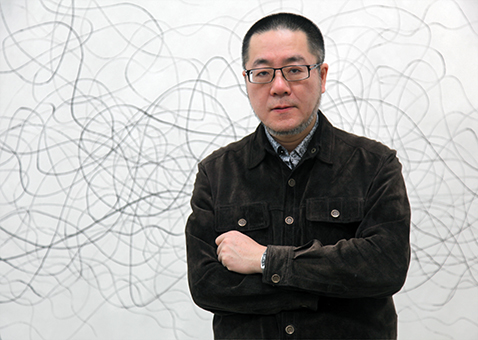
Artist Wang Huangsheng in front of his largest love letter in the show, photo by Chris Phillips
BAPs: If I asked you to draw on the surface of the water, what would you draw?
WH: If I were to continue to draw the movements that you see here in paper [long pause]... if the water is not still and it is a slowly flowing river, I would actually find that image quite poetic. Because once the ink touches the water and you intend to continue to draw, the ink will dissolve in the water and flow down the river. That’s very poetic. I’m entirely inspired by your question—I may have to make another video work.
The Traces Left Behind
Having brought inspiration to this artist with a simple question, I knew better than to inquire further; Wang Huangsheng’s thoughts were already a river in motion. What I later asked, instead, was for an autograph (not realizing that he had already signed a copy of the exhibition booklet just for me). No, I did not ask this out of vanity. It's just that when an artist uses thoughtful lines the way he does, even a little doodle is a work of art. At least in the pages of my book.Wang Huangsheng, if you happen to read this, I'll have you know that I ripped the page off from the booklet where you left your untitled piece (I've been referring to it as a self-portrait), and it is now hanging framed on my wall next to a window with a view to the river. Likewise, thank you for the inspiration.
Wie am Wasser – "los•ge•löst" by Wang Huangsheng – Until April 20th, 2013 - Wednesday-Sunday: 11am-7pm and by appointment [Prince Range: €7,800 - €78,000]
Courtesy of Wang Huangsheng and Jovanny Varela-Ferreyra & Carmen Herold/Berlin Art Parasites. Image Courtesy WiE am WASSER in Berlin, for further information please visit www.wiekultur.de.



